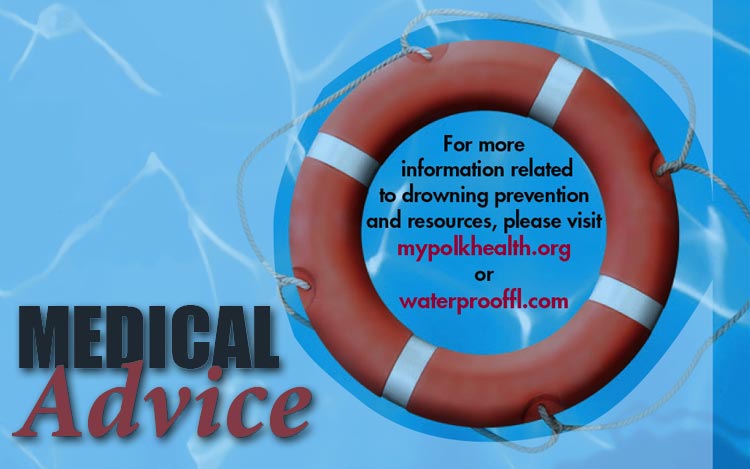SPRING IS THE TIME OF YEAR in Florida when temperatures begin to warm and the weather is perfect outside. With the sun shining and a gentle breeze blowing, this beautiful weather also marks the beginning of swimming season for Polk’s residents. Swimming and boating are two of the most popular summer activities for people living in or visiting Florida.
Drowning is the leading cause of death in children ages one to four, and Florida has the highest rate of child drownings under the age of five in the nation. Polk County has the 12th highest child drowning rate in the state with a count of 25 deaths in 2014. With more than 500 lakes in Polk County, our residents spend a significant amount of time in and around the water.
Because many are so comfortable near the water, residents may be lulled into a false sense of security. It is very important for all Florida residents to be aware of the following water safety tips to keep a fun family outing from turning into a tragedy.
SUPERVISION
Drowning is a silent and deadly killer. It can occur within the small amount of time it takes an adult to check their phone, read a page in a magazine, or run inside for a towel. With the majority of drownings in Polk occurring in residential swimming pools, actively watching children while in the pool is the first line of defense against a drowning accident. Take children with you if the phone should ring or if you should need something from inside the house. Designate one adult to watch the children while they are in the pool; this adult should be 100 percent distraction-free, which means no socializing with other adults, no chores, and no talking/texting on the cell phone. Children should never be in the pool area unaccompanied by an adult.
BARRIERS
Having a barrier between the house and pool could help to reduce the instances of drowning accidents by 50 to 80 percent. Examples of barriers include child-proof locks on all doors, a four-sided fence (at least five feet tall) separating the pool from the house, gates with self-latching/self-closing mechanisms, and door alarms.
SWIMMING LESSONS
The American Academy of Pediatrics recommends that children ages 4-plus learn to swim to prevent drowning. Encourage children, adolescents, and adults to learn to swim. However, remember that swimming lessons are not a substitute for supervision!
EMERGENCY PREPAREDNESS
Learn CPR for youth and adults, especially if you own a pool. It only takes four to six minutes without oxygen to cause lasting brain damage. Valuable life-saving seconds can be lost if waiting for EMS to arrive before beginning CPR. In the case of an emergency, it is critical to have a phone nearby to dial 911. Reaching or throwing aids should also be readily available around the pool.
BOATING SAFETY
When boating, make sure that all passengers are fitted with the appropriately sized life jacket. The U.S. Coast Guard requires all children ages 13 and under to wear a personal floatation device any time they are on a recreational water vehicle. Obey all signs while on the water and keep a close eye out for other boaters and swimmers. In addition, remember that drinking alcohol while boating will impair one’s judgement and reaction times. Drinking and boating is considered drinking and driving.
Swimming can be a great way to enjoy Florida’s natural scenery and escape the heat that accompanies summer. It is our responsibility to ensure the safety of our children, and of ourselves, when in and around the water. For more information related to drowning prevention and resources, please visit www.mypolkhealth.org or www.waterprooffl.com.
CREDIT
article by DR. JOY JACKSON
ABOUT THE AUTHOR: Dr. Joy Jackson, an internal medicine physician, serves the community as director of the Florida Department of Health in Polk County (FDOH-Polk). For more information about FDOH-Polk, visit www.mypolkhealth.net.
Posted April 27, 2016
